Gloomhaven, or How We Spent 2018 (and Wish We’d Spent 2019)
For a year, the only board game my wife and I played was Gloomhaven. We completed 33 scenarios, which is about half what it typically takes to complete the campaign. We were looking forward to playing little else for the next year, but alas, life interfered.
That’s doubly disappointing, as the Kickstarter for Frosthaven, a stand-alone follow-up to Gloomhaven, with all new characters and setting, is scheduled to launch March 31, 2020. (We’ll back it, even though we might not open it until 2022.)
Gloomhaven is a fantasy RPG board game, designed by Isaac Childres, for one to four players. We picked it up at a steal for $75 on its second Kickstarter. It’s big (22 pounds), it’s long, and we don’t know what’s coming. Gloomhaven fits neatly into the cooperative tactical combat legacy fantasy RPG double-deck-builder hand-management storytelling category of board games….
Yeah, I should unpack that, but first let me say that, although this game is number one on Board Game Geek, it’s not for everyone. The initial learning curve is steep, and it’s got a lot of moving parts that someone has to remember to move. I strongly recommend having a meticulous player at the table. (Alternatively, there’s an early access computer version on Steam that looks pretty close to the board game.)
[Click the images for gloomier versions.]
In Gloomhaven, the players control two to four characters (my wife and I usually play two each so we can experience more of them). There are 17 different characters to play, although when you first open the box, only six are available: Brute, Scoundrel, Tinkerer, Mindthief, Spellweaver, and Cragheart. The rest are sealed, becoming available as events unfold, triggers are hit, or goals are reached.
The board is a typical second-world fantasy map, with the city of Gloomhaven figuring prominently. There are 95 numbered locations on the map, each a scenario, but when you open the box, only the first one is available. Decisions you make and successes you achieve over the course of a campaign determine reveal new scenarios, and you add a location sticker to the board each one discovered.
A game session involves deciding on a scenario, taking care of shopping and other city business, engaging in a random city and/or road event, and then playing the scenario, which is the main event. The scenario is played out as tactical combat with miniatures and standees on a modular hex-map board. Often the objective is “kill all enemies,” but there are others.
The core of this tactical combat, and hence the game, is hand management, the design of which is brilliant. And insidious.
Every character has a unique set of action cards and plays two cards per turn, selecting them before the enemy actions are revealed. Each card has a top action and a bottom action. You play the top action from one card and the bottom action from the other. In general, the top action is an attack and the bottom is a move, but there’s a lot of variation and character flavor built into each deck.
At the end of a turn, the cards played are discarded. When a character rests, one card from their discard pile is lost, and the rest are brought back into their hand. If a character’s hand shrinks to the point where they cannot play two cards, they’re exhausted and out of the scenario. Thus a character’s hand is an in-your-face countdown to the end, with your options steadily dwindling. Tick tock, tick tock.
Some actions are one-use. These are lost instead of discarded. The cooler the action, the more likely the card is to be one-use. Thus the more amazing your feats, the quicker you become exhausted. Tick tock, tick tock. But you gain experience points based on the actions you take, and those fancier actions tend to generate more experience points. Decisions, decisions.
Enemies drop coins when they fall, and some scenarios have treasure. Want to collect it? Looting takes place during the scenario, not after, so you’ll need to detour to pick up riches. That means you’re less efficient in moving through the map. Ticktock, ticktock. Or maybe you have a loot action you can play instead of moving or attacking. Decisions, decisions.
If an enemy lands a blow and you don’t want to (or can’t) lose that many hit points, no worries! You can lose a card from your hand or two from your discard pile instead. Ticktockticktock.
The insidious nature of this hand management is not limited to game play. Before diving into a scenario, you select your starting hand. The Brute, for example, has a hand size of 10 cards, and that starting count never changes, but at level one, the Brute has a deck of 14 cards to select from. You must decide which cards to take and which to leave behind. Your deck size increases by one card every time the character levels up (to a max level of nine), so the higher your level, the more cards you can’t take with you.
Don’t worry, it gets worse. Every time a character levels up, two more cards — usually cooler and more powerful than anything you currently have — are made available, of which you can only choose one to add to your deck. The other is probably gone for good. If you choose your starting hand poorly and fail the scenario, you can choose a different hand for your next attempt. But if you choose your leveling-up card poorly, your options fall between bravely soldiering on and weeping over your poor life choices.
There have been times where either my wife or I have spent a few minutes trying to pick that last card we’d take into a scenario. But when faced with the leveling-up card choice, we sometimes leave both of them on the kitchen island for a day and contemplate them every time we walk by, trying to make this critical decision.
Isaac Childres is an evil genius. Heavy on the evil.
You also have a second deck that’s less stressful to build: the attack-modifier deck, which is a randomizer. When you attack an enemy, there’s a base level of damage done (a generic attack does two points), but you also draw from the attack-modifier deck for every creature attacked. The attack-modifier deck starts out as a standard deck with a range of -2 to +2 (bell-curve probability), plus one double-damage card and one no-damage card. Over time you can add better cards and cull the negatives, but what’s available is unique to each character. Brute might add Stun or Pierce to his deck, while Scoundrel might add Poison or Muddle.
The enemies you face get to do things too. Each of the 30 enemy types has a unique action deck of eight cards. They move and fight programmatically, but some enemy types have a lot of variability in their actions, and the first time you fight one, you’re going in blind. A Bandit Archer or a Living Bones might hit you with a small surprise that messes up your plan, but the indescribable things tucked away in rifts? Oh, my.
When you flip that card to reveal an enemy’s actions and initiative for the turn, you’ve already committed to which two cards you’re going to play and what your initiative is, but you’ve still got some wiggle room. Only when it’s your turn do you commit to which card is your top action, which is the bottom, and what order to play them in. No plan survives contact with the enemy, so you’re going to need that wiggle room.
Some players love the tactical aspect of this game, some approach it like a puzzle, and some revel in the roleplaying. I like the whole package, but I live for the big moments this game delivers. Let me give some examples.
Example one: Brute and Scoundrel faced a single enemy in the first room of a scenario. Unfortunately, it was an Elite Flame Demon. Not a lot of health, but a whole lot of armor, and a lot of retaliation damage done every time you attack it. Killing it was not a problem. Killing it efficiently while minimizing our own wounds, big problem. Once it was dead, we were faced with taking a long rest early — inefficient hand management means you get fewer turns — or charging through the next door into a more populated room with a limited hand and more wounds. It’s a subtly bad opening room.
After three failures, I made an adjustment to my starting hand and told my wife to ignore the demon and run for the door to the next room. On the first turn I pulled out one of Scoundrel’s big actions, turning the demon’s armor against it and killing it in one blow. Alas, that action is single-use. Scoundrel has a hand-size of nine cards, so using it before my first rest meant losing four turns on the back end, guaranteeing Scoundrel would fall.
It also meant Brute was through that door without a scratch on his second turn. When Scoundrel fell, Brute had plenty left in him to get the job done. Yay, math.
Example two: Scoundrel fell, exhausted, and Brute only had one turn left in him. There was a bad guy in front of him, and an unopened door across the corridor with who-knew-what behind it. My wife played Brute as enraged by Scoundrel’s fall. “No!” He cut down the enemy in front of him with one action and, my wife bellowing as he charged, blew through the unopened door with the other action, a trample that attacked anyone he moved through.
A peek inside that massive box
As it happened, there was only one enemy in that room, and Brute had enough movement (with magic boots to give him a boost) to run it over. His trample isn’t a strong attack, but with a good draw on the attack modifier, it was enough. The mix of a victory and my wife’s roleplaying made this a memorable moment for me.
Example three: On another frustrating scenario, Brute fell for the third time, leaving Scoundrel facing a Living Corpse (a slow-moving pile of hit points) and two Living Spirits (weaker, but with armor and ranged attack). The corpse was hurt and standing next to me. The spirits were unhurt and at range. I had three cards, two hit points, and a certainty that this would be my last turn.
My wife was already planning her hand for our next attempt, but I was eying two of my cards. “Theoretically, I can do this.”
Scoundrel is fast, so I knew I’d go before either enemy type. For my first action, I used a card that has an attack on the bottom instead of a move. (Scoundrel has her tricks.) That action has a base damage of three, which is how many hit points the Living Corpse had left. All I had to do was not draw a negative modifier, and I didn’t. That was the easy one.
For my second action, I used the Scoundrel go-to of throwing knives, which is a weak ranged attack, but against two targets. The knives do two points of damage. The spirits had two hit points but also two points of armor. I drew the first attack modifier. Plus two; the enemy fell. I put my fingers on the attack-modifier deck, paused (because why wouldn’t I), and drew… double damage. The other enemy fell and we cheered. Loudly. It was awesome.
In fact, it was probably as awesome a moment as I’ve had in any board game.
Combat is the core of the game, but everything outside of that builds on the story. There’s city history to reveal and a secret message to decipher. The city and road events consist of small bits of story with a choice to be made. They might affect the party’s reputation or the city’s prosperity (both important stats). They might reveal a new scenario or introduce an NPC you can run into later. If any of the PCs have met their secret personal goal and retired, they might show up again in one of these events.
In short, our campaign so far has been a rich experience punctuated by moments of awesome. And many, many decisions.
A final note: This is the only board game we bought box inserts for, which cost as much as the game. I’m glad we did. Usually I’m good with baggies and folded paper boxes, but well-organized contents will save you a lot of setup time on this one.
Jeff’s last article for us was Audio Fiction from Rusty Quill.
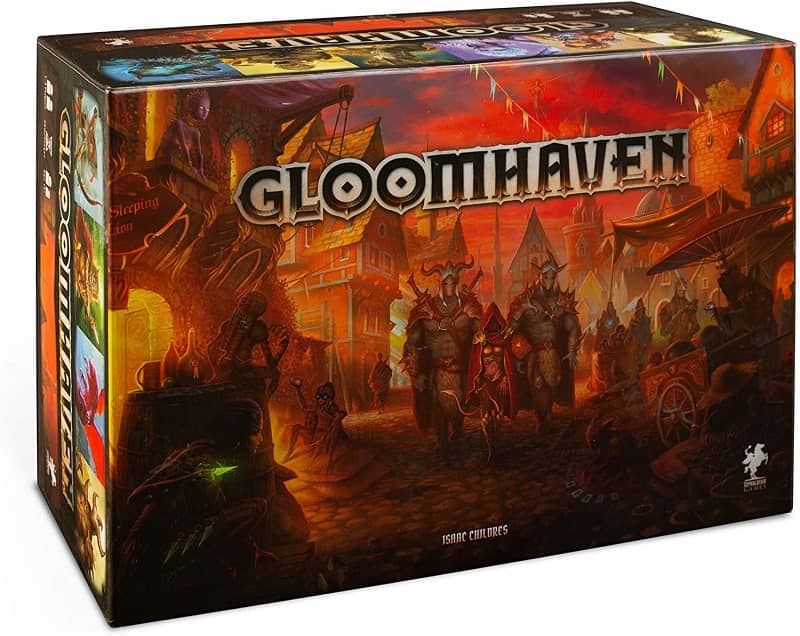
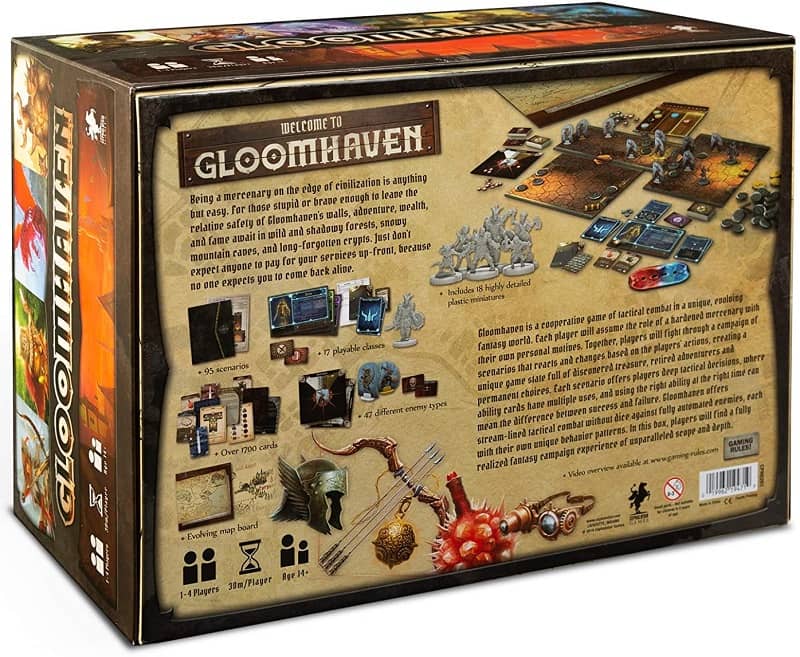
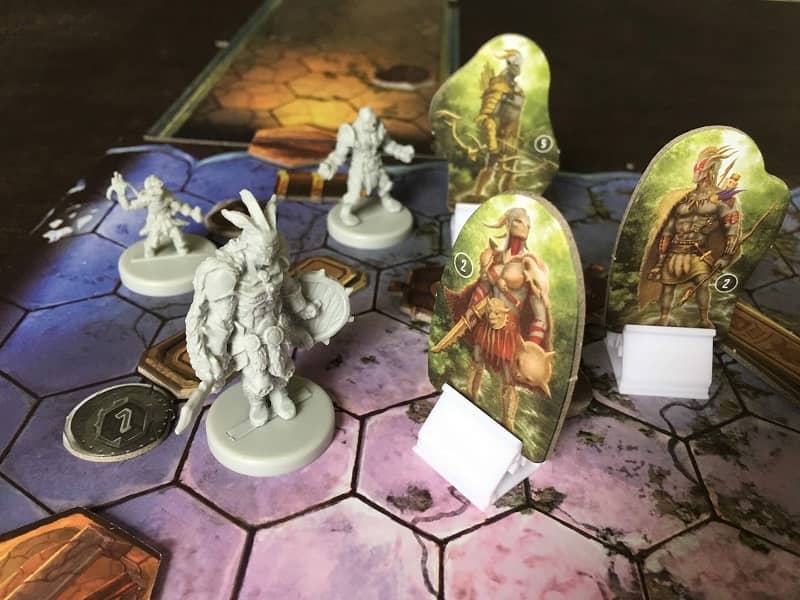
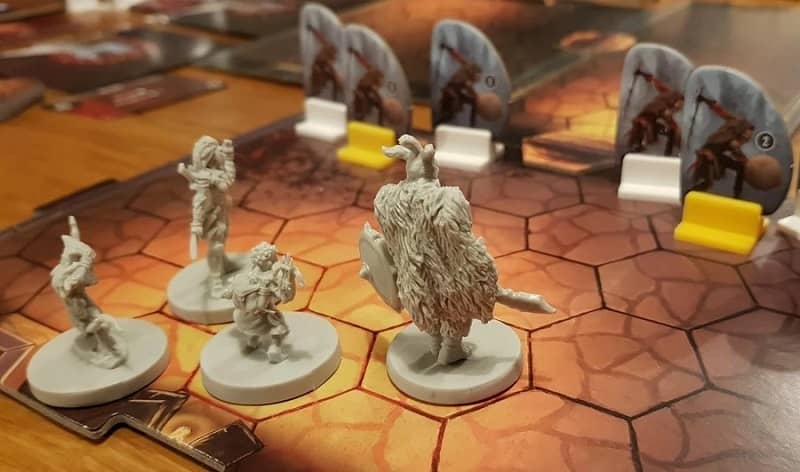
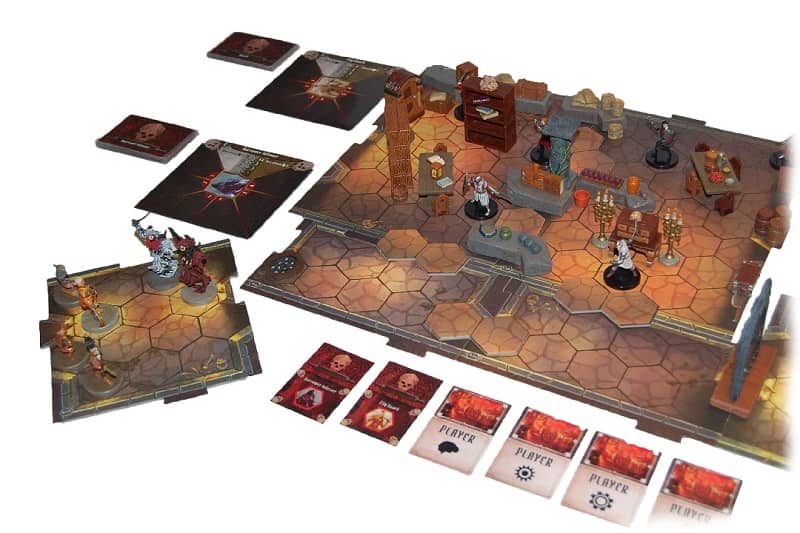
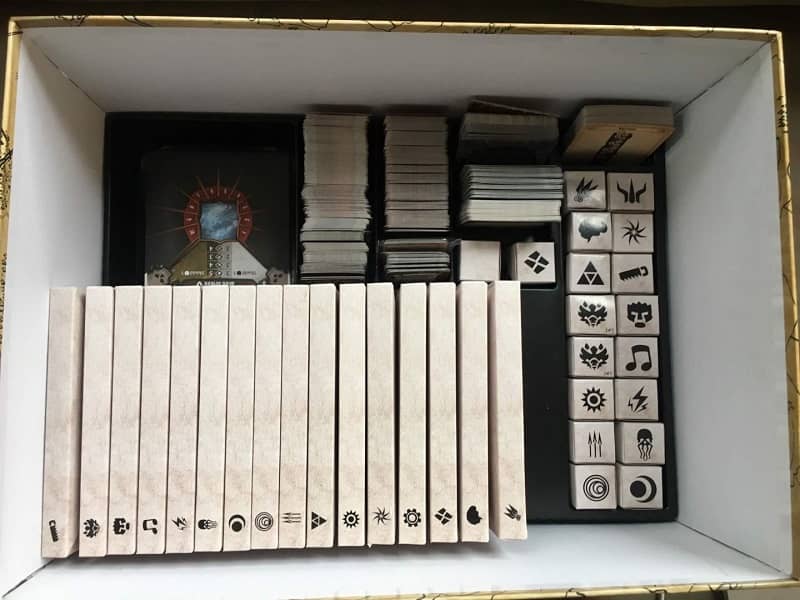
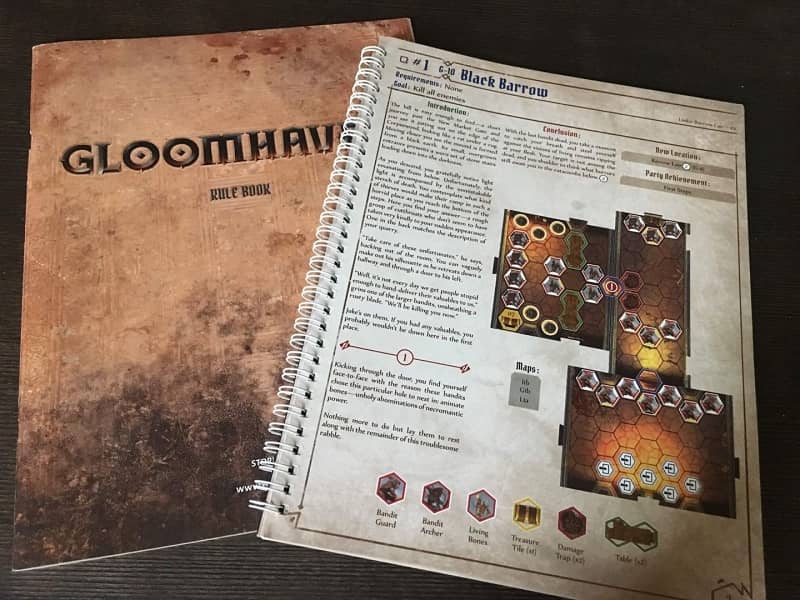
Gloomhaven does sound like a major immersive experience for months on end. And while narrative-style games are very popular, there is still something I love about the use of random elements that make the success of a well-thought-out plan that much sweeter. Congrats, Mr. Stehman, to you and your wife! Please do regale us with more tales of your campaigning.
I bought a copy of this a few months after it came out. But this is the first review that has really made me want to crack open my copy.
Thanks Jeff!
@Eugene, thanks. My boss was annoyed when we stopped playing and I could not longer give him my Monday morning Gloomhaven report.
But I don’t plan on telling more Gloomhaven stories on BG. Like the time we had reduce our party to our two fastest characters, so we could run past our enemies on a problem scenario. Or about the scenario we failed a couple of times, but where my wife’s opening move with Spellweaver was so cool (KABOOM!) that we didn’t mind playing it again. Nope, you won’t hear any of that from me.
@John, you can thank me or hate me later, depending on which side you come down on. 🙂
My game group has been playing Gloomhaven for about 2 years, and having a ball with it. The best investment we made to help with the game were several sets of figure bases from Etsy that let you track the monster hit points on each figure, rather than using the counters that come with the game. Well worth the money for the time saved in game. https://www.etsy.com/listing/591962176/gloomhaven-monster-bases-pkg-4
@rjmiller, those look handy. Is there room to prop two more status tokens behind the ones that are slotted?
With the first day not done, the Frosthaven kickstarter is off to an unsurprising start, with over $4 million pledged on a goal of $500K.